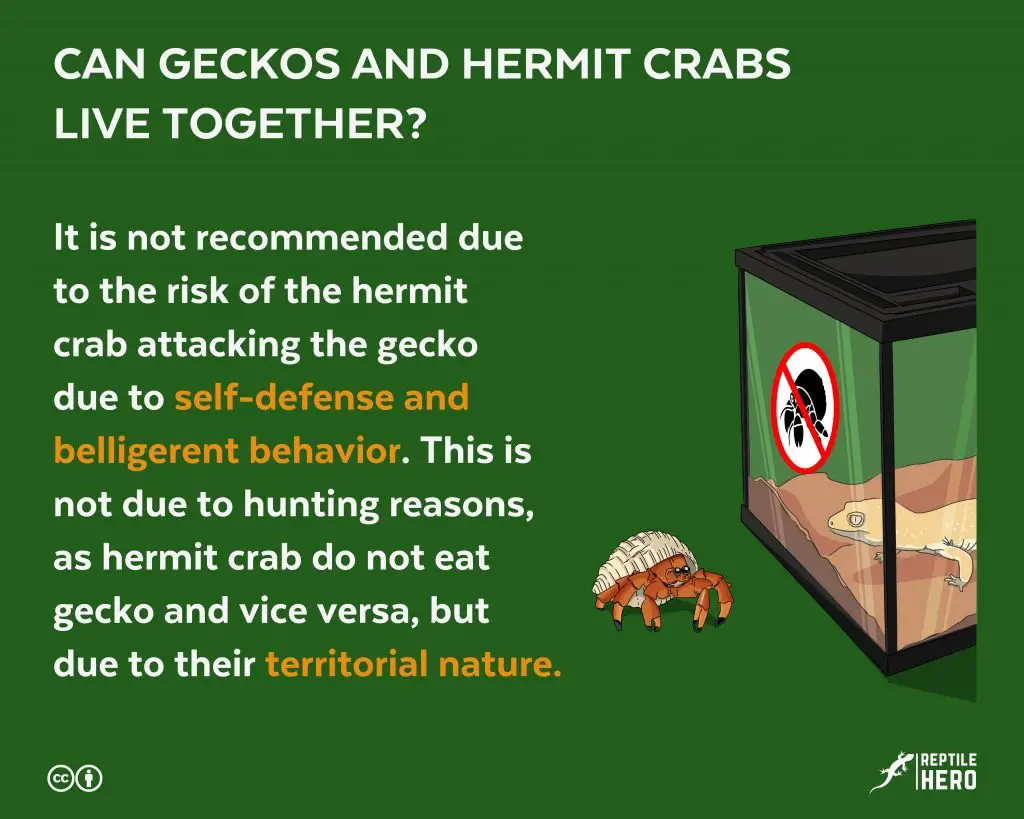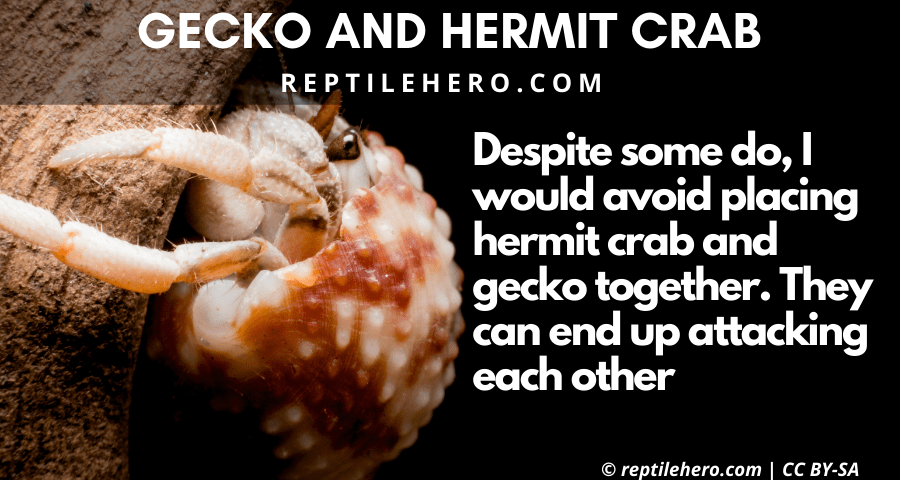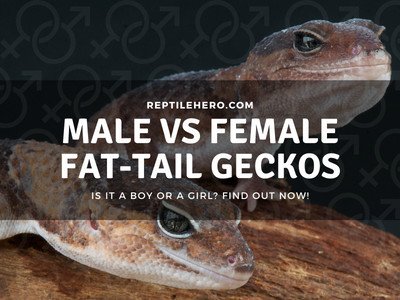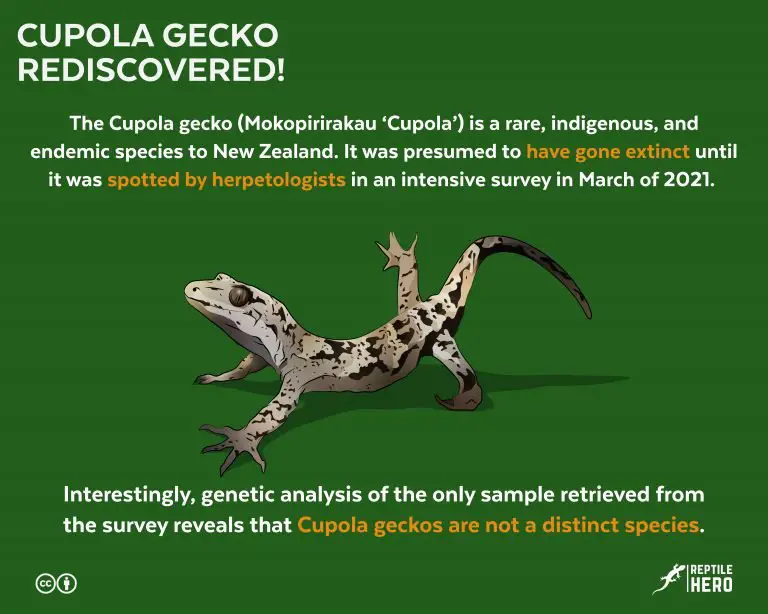Can Geckos and Hermit Crabs Live Together?
If you like keeping geckos and hermit crabs as pets and you want to save space, you’d like to know if it’s safe to put them together in one terrarium or glass tank. You might be confused when you search online for answers.
Despite hermit crabs and geckos can theoretically live together any some keep them in the same tank, this is not recommended due to the risk of the hermit crab attacking the gecko due to self-defense of belligerent behavior. This is not due to hunting reasons, as hermit crab do not eat gecko and vice versa, but due to their territorial nature.
This question is a hotly debated topic. On one hand, some people want to put their pet geckos and hermit crabs together in one tank to conserve space or simply for variety. But, the question is, are your pets safe or not?

Hermit Crab and Gecko Together? Those That Agree
Many say that yes, you can put geckos and terrestrial hermit crabs to live together in one tank – of the right size because of their similar diet, habitat, humidity, and habits requirements.
Diet
Geckos don’t eat crabs, and hermit crabs don’t eat geckos. Most geckos feed on insects such as ants, flies, and cockroaches, as well as worms, beetles, and sowbugs.
Most hermit crabs can eat vegetables, noncitrus fruits, fish flakes, nuts, seaweed, and brine shrimp
Habitat
Hermit crabs prefer moving on the ground more than geckos do. Most geckos often stay in high places such as walls, branches, and trees. Hermit crabs, as a rule, stay on the ground or hide underground cover (moss, bark, etc.) or in hollow areas (tubes, shells, etc.).
Humidity
Tanks with the right level of humidity can accommodate both pets. Hermit crabs that live on land need fresh and salty water, which increases humidity levels in the tank. Many gecko species are from dry desert areas, but you can choose geckos that come from humid rainforests or tropical areas.
Habits
You can choose species with compatible habits to stay together in one tank.
Hermit crabs like to arrange their environment at night and are mostly still in daylight.
Geckos are mostly active at night, but you can also choose gecko species that are diurnal (active in the day).
Many pet shops and pet owners say that geckos can adjust to new environments. While they may come from a drier or hotter climate, generations of offspring from imported parents can live in new or different local conditions.
Below one of the controversial videos on the topic where an owner claimed to keep both of them together. However, the reaction from other pet owners (in the comments) is not that positive as I was expecting
Why Hermit Crab and Geckos Cannot Stay Together
Other people say that no, you shouldn’t put geckos and hermit crabs together. They insist that separate tanks are better because
Habits
If both species are nocturnal, they might disturb and harm each other if they get too close to one another.
Geckoes are solitary creatures. Most gecko species are nocturnal (active at night) and sleep during the day. As mentioned, hermit crabs often rearrange their environment at night. Geckoes are also aggressively territorial and bite to defend their space against intruders or other geckos. Land hermit crabs are also territorial and are often aggressive towards one another.
This is a sure recipe for fights between them at some point when probably you are not around (at night) to do anything on the matter. Remember that both geckos and hermit crab, in nature, they do not share the same environment.
Humidity
Hermit crabs need a humid environment with enough water because they are coastal animals. As a result, there will be too much moisture in the tank for most types of geckos.
Temperature
Geckos and hermit crabs need different temperatures. For example hermit crabs need a temperature range between 75 and 85 degrees Fahrenheit (or 23 to 29 Celsius) during daytime and from 65 to 75 degrees F (18 to 24 C) at nighttime. They will die if the temperature is higher than 85F. Geckos need at least 95F for basking.
Self-defense: Many types of geckos have belligerent attitudes and can inflict bites if they feel that they are threatened. Despite the bite might be not a problem for us humans it might be seen as a threat by a smaller creature as a crab that can use its claw to grab the gecko.
What You Can Do
I do personally do not recommend placing hermit crab and gecko together. Place them in different tanks.
However, if you really want (do not tell that I did not advise you), here are four (4) useful tips for those who want to go ahead and put geckos with hermit crabs in the same tank.
Choose Your Hermit Crabs
Hermit crabs are so named because they use the shell of other animals for their homes. As they grow, they move out and find a bigger shell to carry around. Unlike marine hermit crabs, terrestrial hermit crabs mostly live on land and require both salt and freshwater sources.
There are more than 15 species of terrestrial hermit crabs, and the following are the most popular choices for pets (I’m using scientific names here because their common names can be different, depending on who’s talking).
Don’t be surprised if you find photos that show hermit crabs in different shells. Keep in mind that they occupy empty shells of any animals. Let’s not judge a hermit crab by its cover. In fact, they’ve been seen to occupy empty cans, bottle caps, broken bottles, or plastic pipes.
| Common Name | Scientific Name |
|---|---|
| Australian land hermit crab | Coenobita variabilis |
| Big land hermit crab | Coenobita cavipes |
| Caribbean hermit crab | Coenobita clypeatus |
| Ecuadorian hermit crab | Coenobita compressus |
| Large hermit crab | Coenobita brevimanus |
| Ruggie hermit crab | Coenobita rugosus |
| Strawberry hermit crab | Coenobita perlatus |
You can also find hermit crabs on shorelines of sub-tropical areas such as in the Florida Keys, the West Indies and South America. Most are nocturnal animals and hide under sand, rock pockets or hollows, or driftwood.
However, some types also climb trees. You don’t want to put tree-type hermit crabs together with geckos.

Choose Your Geckos
As we know, some species such as the leopard gecko are used to the fairly dry environment of the desert, so the ideal humidity level for them is about 30% to 40%. A terrarium with a screen top or a similar ventilation that matches your room’s humidity should keep them dry.
For example, species such as the crested gecko love environments that are between 60% to 80% humid. Since constant moisture can result in mildew or mold growth, it is best to keep the tank, soil, and water very clean.
If the humidity level in the gecko’s tank is often too high, your pet gecko is likely to develop some serious skin-related infections and respiratory issues such as pneumonia. At the same time, fungus and bacteria can grow in highly humid environments.
To measure humidity, it is recommended that you use a hygrometer (humidity gauge) at the cooler end of the gecko’s tank. It is best to attach a hygrometer inside the tank to keep track of humidity levels at all times.
You should be using ultraviolet light at low levels. Using harsh light at night can disrupt the night-day cycle of nocturnal geckos.
On the other hand, you could also choose geckos that can live in environments with higher humidity levels that are suitable for hermit crabs.
- Tropical house geckos, also known as Afro-American house gecko or cosmopolitan house gecko (Hemidactylus mabouia) are used to high humidity in the tropics.They eat insect pests such as spiders, scorpions, cockroaches, moths, anoles and other geckos.
- Bridled forest geckos (Gonatodes humeralis) are used to the humid air in rainforests of the Amazon. They prefer tree branches and eat insects, ants, cockroaches, caterpillars, mollusks, and earthworms.
- Turnip-tailed geckos (Thecadactylus rapicauda) are used to the highly humid environments in Mexico, Brazil, and South America. They feed on insects and cockroaches.
- Leopard geckos (Eublepharis macularius) from the tropical environments of Afghanistan, India, and Iraq can thrive in a tank with a basking area at one end at 86 to 88 degrees Fahrenheit, as well as a cooler area (around 70 degrees) at the other end.
- African fat-tail geckos (H. caudicinctus) are natives of humid environments with a humidity level between 70 to 80 percent. A ground cover that retains moisture such as peat moss can increase humidity.
- Tokay geckos (Gekko gecko) from Asia, India, and Indonesia also prefer the humid environments of Asian countries.
- Madagascar Geckos: Terrestrial hermit crabs thrive in humidity levels from 70 to 80%. Gecko species from Madagascar are used to an average humidity of about 82%. Here are some examples of geckos from that area:
Table 2: Selected Geckos Native to Madagascar
| Common Name | Scientific Name |
|---|---|
| Frilled leaf-tailed gecko | Uroplatus henkeli |
| Giant leaf-tailed gecko | Uroplatus fimbriatus |
| Guenther’s leaf-tailed gecko | Uroplatus guentheri |
| Lined leaf-tailed gecko | Uroplatus lineatus |
| Madagascar day gecko | Phelsuma m. madagascariensis |
| Satanic leaf-tailed gecko | Uroplatus phantasticus |
| Spearpoint leaf-tailed gecko | Uroplatus ebenaui |
| Mossy leaf-tailed gecko | Uroplatus sikorae |
Know Your Humidity Levels
To simplify, humidity refers to how much water vapor is present in the air. Highly humid air includes rainfall, fog, mist, or dew.
Places with high temperature and are near big bodies of water (seas, lakes, large rivers) are often humid since the heat evaporates water into gas. Tropical rainforests and countries near the equator with a lot of rainfall are humid areas.
You can choose geckos from places with high humidity, as these are the gecko species that can live in a humid terrarium that’s also appropriate for hermit crabs.
Choose Your Tanks
It’s quite important to know the kind of tanks to use when you have pet geckos and hermit crabs. Of course, you need to know the right size (measured in gallons), width, length (you’ll need space for both land and water), and height (geckos like to climb).
If you’re talking to tank suppliers or sharing with other pet lovers, you want to use the right names for the right tanks. Here’s a quick guide.
Table 4:
| What’s Inside | Aquarium | Paludarium | Riparium | Terrarium |
|---|---|---|---|---|
| Contents | Water | Generally humid | Generally Water | Generally dry |
| Water | Yes | Yes | Yes / Mostly | No / A Little |
| Land | No | Yes / Mostly | Yes / A Little | Yes |
| Plants | Sometimes | Yes | Yes | Sometimes |
| Land animals | No | Sometimes | No | Sometimes |
| Aquatic animals | Yes | Sometimes | Sometimes | No |
| Semi-aquatic animals | No | Sometimes | No | No |
| Humidity | Not applicable | High | Average | Low |
| Misting | Not applicable | Sometimes | Sometimes | No |
- Vivarium: A vivarium is any enclosure (glass or any material) that is designed to provide a stable environment for plants, animals or both. In short, a vivarium can be an aquarium, a terrarium, a paludarium, a riparium, an insectarium, and so on.
- Aquarium: The Latin word “aqua” refers to water. As we know, aquariums are for fishes, so it contains water. Any land area would be underwater as well. Here’s where we keep aquatic animals that breathe underwater: fish, shrimps, snails, aquatic plants, and so on.
- Terrarium: The Latin word “terra” refers to land, soil, or earth. So this is the dry equivalent of an aquarium, and is designed for plants and animals (ants, land crabs, snails, spiders, scorpions, geckos, and the like) in a relatively dry environment, usually with low humidity. They have a screen mesh at the top for airflow. Doors for feeding and cleaning may be at the top, front, or side.
- Paludarium: The Latin word “palus” refers to swamp or marsh. This tank is semi-aquatic, designed for animals that need an environment that is part land and part water with high humidity. Examples of semi-aquatic pets are turtles, frogs, snails, crabs, and lizards.
- Riparium: A riparium is a tank that is similar to a paludarium, except that there is a very large water area and very tiny land area. This is the best environment for keeping freshwater crabs, snails, dwarf shrimp, crayfish, and fish.
Takeaways
And there you have it. You now know what the debate about putting geckos and hermit crabs together is all about.
Before you go, here’s a list of takeaways that you can easily remember:
- Some say it’s OK: Many sources state that geckos and hermit crabs can coexist in the same tank.
- Others say it’s not OK: Others say that geckos and hermit crabs should not be placed in the same tank.
- What you can do: Since geckos are known to be able to adjust to new environments, you could try and choose the hermit crabs and geckos with compatible habits, environments, humidity levels, and types of tanks. Observe and choose what works best for your own situation.
If you have questions about this article, please let me know!





![Are Terrariums and Vivariums the Same? [6 Differences]](https://www.reptilehero.com/wp-content/uploads/2021/06/Terrarium-vs-Vivarium-768x614.jpg)
![5 Causes of Denting on Your Gecko Eggs [and 4 Solutions]](https://www.reptilehero.com/wp-content/uploads/2021/03/G38-768x614.jpg)